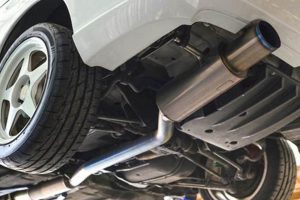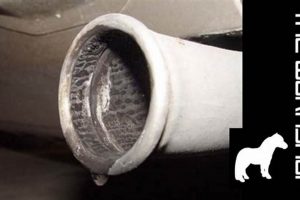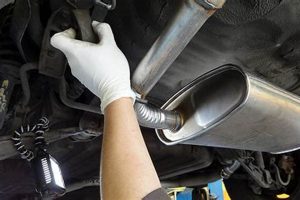The removal of a vehicle’s muffler is a modification concerning the exhaust system that alters the sound output. The muffler’s primary function is to reduce noise generated by the engine. Deleting this component results in a louder exhaust note.
The popularity of muffler modifications stems from the desire for an enhanced auditory experience and, in some cases, a perceived increase in engine performance. Historically, modifications to exhaust systems have been common among automotive enthusiasts seeking to personalize their vehicles. However, the impact of such alterations on vehicle longevity and legality must be considered.
The following sections will examine the potential drawbacks and advantages associated with the removal of a muffler, assessing the technical and legal ramifications for vehicle owners.
Considerations Regarding Muffler Removal
Muffler modifications alter a vehicle’s exhaust characteristics. A thorough understanding of potential consequences is crucial before undertaking such a change.
Tip 1: Noise Level Assessment: Evaluate local noise ordinances before considering muffler modification. Increased exhaust volume may violate regulations, leading to fines or legal repercussions. Verify the specific decibel limits permitted in the operational area.
Tip 2: Potential Performance Impact: While some claim improved engine output after muffler removal, this is not always the case. Without corresponding engine management calibration, the alteration may negatively affect backpressure, potentially reducing low-end torque.
Tip 3: Emissions Compliance: Muffler removal may indirectly affect emissions testing. Although the muffler itself is primarily a noise reduction device, significant alterations to the exhaust system can impact catalytic converter efficiency. Ensure continued compliance with emission standards.
Tip 4: Structural Integrity: Removing the muffler may expose the exhaust system to increased stress and vibration. Consider the need for additional support or reinforcement to prevent damage to other exhaust components.
Tip 5: Professional Consultation: Consult with a qualified automotive technician before proceeding with muffler removal. A professional assessment can identify potential compatibility issues and ensure proper installation techniques.
Tip 6: Resale Value: Understand that modifying the exhaust system may negatively impact the vehicle’s resale value. Potential buyers may be deterred by the altered exhaust note or concerns about the modification’s impact on vehicle reliability.
Careful consideration of these points mitigates potential drawbacks associated with muffler removal. Prudent planning ensures informed decision-making.
The following section will delve into the long-term effects of this type of modification.
1. Backpressure alterations
The relationship between muffler deletion and backpressure alterations is a critical consideration regarding potential harm to a vehicle. The exhaust system, including the muffler, is engineered to manage exhaust gas flow, maintaining a specific level of backpressure. Removing the muffler changes the system’s flow characteristics, potentially decreasing backpressure. Engine performance can suffer if backpressure falls outside the designed range. For example, reduced backpressure can lead to a decrease in low-end torque, noticeable as sluggish acceleration from a standstill. Conversely, excessive backpressure is also detrimental, impeding exhaust flow and reducing overall power. The importance of understanding this interaction lies in preventing unintended performance degradation following a muffler modification.
The impact of backpressure changes depends on the engine type and vehicle configuration. Naturally aspirated engines are typically more sensitive to backpressure alterations than turbocharged engines. A vehicle with a highly tuned exhaust system may experience more significant performance changes from a muffler deletion than a vehicle with a stock exhaust. Furthermore, the engine control unit (ECU) plays a role in compensating for altered exhaust flow. Modern ECUs can adjust fuel delivery and ignition timing to optimize engine performance, mitigating some of the negative effects of reduced backpressure. However, the ECU’s ability to adapt is limited, and significant backpressure changes can still result in suboptimal performance.
In summary, muffler deletion’s impact on backpressure can affect engine performance. Although potential effects vary depending on vehicle specifications and ECU capabilities, a thorough understanding is essential for avoiding unintended harm. Consulting a qualified technician to assess the vehicle’s specific requirements before proceeding with such modification is recommended.
2. Emissions implications
Muffler removal’s impact on vehicle emissions represents a critical consideration. While the muffler itself primarily functions as a noise reduction device, alterations to the exhaust system can indirectly affect emissions control components. The catalytic converter, responsible for reducing harmful pollutants in exhaust gases, relies on specific exhaust gas temperatures and flow rates to operate effectively. A modified exhaust system, lacking the muffler’s backpressure, may alter these parameters, potentially reducing the catalytic converter’s efficiency. For instance, an engine with a less efficient catalytic converter will emit higher levels of hydrocarbons, carbon monoxide, and nitrogen oxides, exceeding legal limits. Consequently, vehicles may fail emissions inspections, preventing registration and legal operation.
Furthermore, some vehicles employ oxygen sensors located downstream of the catalytic converter. These sensors monitor the converter’s performance and provide feedback to the engine control unit (ECU). If the ECU detects reduced catalytic converter efficiency due to altered exhaust flow after a muffler deletion, it may trigger a check engine light and implement corrective measures, such as adjusting fuel trim. Such adjustments, while intended to mitigate emissions increases, can negatively affect engine performance and fuel economy. In certain jurisdictions, tampering with or rendering inoperative any emissions control device is a violation of federal or state law, carrying substantial fines and penalties. The absence of a muffler may also raise suspicion during visual inspections, prompting a more thorough examination of the exhaust system.
In summary, muffler removal introduces potential emissions-related complications. Although the muffler does not directly control emissions, its removal can indirectly impact the functionality of critical emissions control components, such as the catalytic converter. This, in turn, may lead to increased pollutant emissions, failed inspections, legal penalties, and impaired vehicle performance. Therefore, carefully evaluate the potential emissions ramifications before considering muffler modifications, as compliance with environmental regulations is paramount.
3. Noise regulation violations
Noise regulation violations are a direct consequence of modifying a vehicle’s exhaust system through muffler removal. The muffler’s primary purpose is to attenuate engine noise, bringing sound levels within legally permissible limits. When this component is removed, the resultant increase in exhaust volume frequently exceeds these established thresholds. Local and national ordinances specify maximum decibel levels for vehicle operation, particularly in residential areas or during nighttime hours. Disregarding these regulations leads to citations, fines, and potential legal action against the vehicle owner. The presence of a muffler ensures compliance; its absence demonstrably increases the likelihood of violating noise restrictions.
The practical significance of understanding the link between muffler modifications and noise violations lies in avoiding legal penalties and maintaining community harmony. Enforcement of noise regulations varies by jurisdiction, ranging from warnings to substantial fines and mandatory vehicle inspections. For example, a vehicle with a modified exhaust system may be impounded until the owner restores it to its original, compliant configuration. Furthermore, repeated violations can result in more severe consequences, including license suspension. Beyond the legal ramifications, excessive vehicle noise disrupts residential peace, leading to complaints and strained community relations. Responsible vehicle operation necessitates adherence to noise regulations, underscoring the importance of retaining a functioning muffler.
In conclusion, the direct relationship between muffler removal and noise regulation violations presents a tangible risk to vehicle owners. Legal repercussions, ranging from fines to vehicle impoundment, and the disruption of community peace serve as compelling reasons to maintain a compliant exhaust system. Understanding and adhering to noise regulations are essential aspects of responsible vehicle ownership, effectively mitigating the potential harm associated with muffler modifications. Prioritizing compliance ensures legal operation and fosters positive community relations.
4. Potential component damage
Muffler removal alters exhaust dynamics, potentially causing damage to other vehicle components. Understanding these potential effects is crucial to evaluating if “does a muffler delete hurt your car”.
- Exhaust Manifold Stress
The exhaust manifold, directly connected to the engine, endures high temperatures and pressure fluctuations. When a muffler is removed, these fluctuations may amplify, leading to increased stress on the manifold. Cracks or warping of the manifold can occur over time, necessitating costly repairs. In extreme cases, exhaust leaks from a damaged manifold can compromise engine performance.
- Catalytic Converter Degradation
The catalytic converter relies on specific exhaust gas temperatures for optimal function. Muffler removal can alter these temperatures, either cooling or overheating the converter. Overheating can melt the internal substrate, rendering it ineffective, while excessive cooling reduces conversion efficiency. A damaged catalytic converter triggers error codes and requires replacement to meet emissions standards.
- Exhaust Pipe Corrosion
The muffler shields downstream exhaust pipes from moisture and road debris. Without this protection, these pipes become more susceptible to corrosion, particularly in environments with road salt. Rust weakens the metal, eventually leading to leaks and structural failure. Replacing corroded exhaust pipes adds to the long-term cost of muffler removal.
- Engine Mount Strain
The altered exhaust vibrations from a muffler delete can transmit through the exhaust system to the engine mounts. Increased vibration accelerates wear on the mounts, potentially leading to premature failure. Worn engine mounts allow excessive engine movement, which can damage other components and create noticeable noise and vibration.
These facets highlight the potential for component damage following muffler removal. While the immediate effect may be an altered exhaust note, the long-term consequences can involve costly repairs to multiple systems. Therefore, considering the potential for collateral damage is a critical part of evaluating if a muffler deletion is a worthwhile modification.
5. Warranty voidance risk
The removal of a muffler presents a notable risk of voiding a vehicle’s manufacturer warranty. Warranty agreements typically stipulate that modifications outside the manufacturer’s specifications can invalidate coverage, particularly when the modification directly contributes to component failure.
- Direct Causation Clause
Warranty contracts often include clauses stipulating that damage resulting from modifications is not covered. If a muffler deletion is deemed to have caused or contributed to a subsequent engine or exhaust system failure, the manufacturer may deny warranty claims related to those parts. For example, if altered exhaust backpressure from the modification leads to premature engine wear, associated repair costs would likely not be covered.
- Aftermarket Part Implications
The installation of aftermarket parts, such as those used to facilitate muffler removal, can raise warranty concerns. Manufacturers may argue that the non-OEM part contributed to the failure, even if the connection is indirect. Documentation from the vehicle owner detailing the installation process and specifications of the aftermarket components will likely be scrutinized if a warranty claim is submitted.
- Powertrain Coverage Limitations
Muffler modifications frequently affect the powertrain, the core of many vehicle warranties. Any perceived negative impact on the engine, transmission, or related systems resulting from the modification provides grounds for the manufacturer to void the powertrain warranty. Substantiating that the modification did not contribute to the failure is the responsibility of the vehicle owner.
- Burden of Proof
The burden of proof often rests with the vehicle owner to demonstrate that the muffler deletion did not cause the reported issue. Gathering expert opinions or independent assessments may be required to counter a manufacturer’s claim that the modification resulted in the damage. Legal recourse may be necessary if the manufacturer refuses to honor the warranty despite evidence to the contrary.
These considerations underscore the significance of understanding warranty implications before undertaking a muffler modification. While the audible benefits may be appealing, the potential loss of warranty coverage presents a substantial financial risk, should subsequent mechanical issues arise. Vehicle owners should consult their warranty documents and seek professional legal advice to assess their specific situation before altering their exhaust system.
Frequently Asked Questions
The following questions address common concerns regarding the removal of a vehicle’s muffler and its potential consequences.
Question 1: Does muffler removal enhance engine performance?
While some claim an increase in power, particularly at higher RPMs, this is not universally observed. In certain instances, the alteration can negatively affect engine backpressure, leading to a decrease in low-end torque. Dyno testing is necessary to ascertain any quantifiable change.
Question 2: Will a muffler delete cause the vehicle to fail an emissions test?
Potentially, yes. Although the muffler primarily reduces noise, changes to the exhaust system can impact catalytic converter efficiency. Vehicles must adhere to emissions standards; failure to do so results in test failure.
Question 3: Is muffler removal illegal?
The legality of muffler removal depends on local and national noise regulations. Many jurisdictions have noise ordinances with decibel limits. Exceeding these limits can result in fines or other legal penalties.
Question 4: Can a muffler delete damage the engine?
In some cases, yes. Altering exhaust backpressure can place undue stress on engine components. Inappropriate backpressure can, over time, lead to premature wear and potentially damage the engine.
Question 5: Does muffler removal affect fuel economy?
The effect on fuel economy is not consistent. Depending on the vehicle and driving conditions, changes in fuel consumption may be negligible or noticeable. Some report a slight decrease in fuel economy due to altered engine efficiency.
Question 6: Will removing the muffler void the vehicle’s warranty?
Potentially, yes. Manufacturers’ warranties often stipulate that modifications can void coverage, particularly if the modification is deemed to have caused a subsequent failure. Consult the warranty documentation for specifics.
In summary, muffler removal can have varied effects on a vehicle. While some may desire the altered sound, the potential for legal issues, emissions non-compliance, and component damage should be carefully considered.
The subsequent section provides a concise summary of the key points discussed.
Concluding Assessment
This exploration has examined the multifaceted implications of muffler removal on vehicle performance, regulatory compliance, and long-term mechanical integrity. Key considerations include potential alterations to engine backpressure, indirect effects on emissions control systems, the risk of violating noise ordinances, the potential for component damage due to increased stress and vibration, and the possibility of warranty voidance. Each aspect contributes to a comprehensive understanding of the ramifications associated with this modification.
The decision to remove a muffler requires careful deliberation, balancing the desired auditory enhancement against potential technical and legal repercussions. Prioritizing thorough research, professional consultation, and adherence to applicable regulations is paramount. Vehicle owners must weigh the immediate benefits against the long-term implications for vehicle health and legal compliance. Prudent decision-making ensures responsible vehicle ownership and mitigates potential negative consequences.







